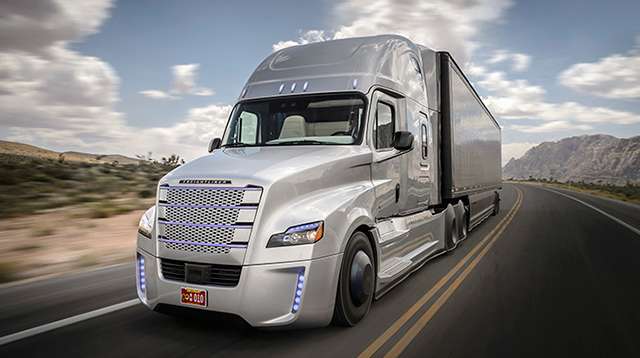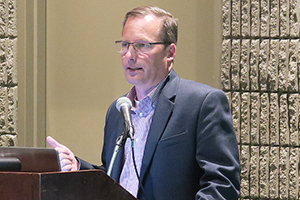Senior Reporter
NACFE Expands Focus to Include Future Technologies

ATLANTA — The North American Council for Freight Efficiency announced an expanded organizational strategy, including an updated brand identity and website, as it seeks to guide the development and eventual implementation of future technologies.
At the same time, the group released an in-depth report on Run on Less — a fuel-efficiency roadshow it held in 2017 involving seven heavy-duty trucks that achieved strong fuel-economy gains using currently available technology.
The group’s expansion plans call for first studying electric trucks, then, later, autonomous trucks, vehicle connectivity, mode-shifts and freight-matching.

Roeth by Joseph Terry/Transport Topics
NACFE made its announcements March 4 at the Technology & Maintenance Council’s annual meeting.
“NACFE is into guiding future change. Our plan is sometime this spring to release a guidance report we are calling ‘Electric Trucks, Where They Make Sense’,” said NACFE Executive Director Mike Roeth.
“Like what we have been doing on scaling available technologies [and issuing related confidence reports], we are now looking at future products coming down the road. We are calling those guidance reports very intentionally. With these new technologies, we don’t have much experience,” he said.
One of the conclusions NACFE reached after issuing its earlier driver-assisted two-truck platooning confidence report was that there likely exists a solid total cost of ownership opportunity that comes with more automation.
However, Roeth said it was not yet clear what level of automation NACFE would be studying in its eventual guidance report.
“I don’t know if we will jump to guidance reports on self-driving trucks and work our way back, or take more of a level 2, 3, 4 approach [covering partial, conditional and high automation, respectively],” he said.
One supplier executive said NACFE’s expanded coverage was timely.
“NACFE’s demonstrated approach to determining the viability of an existing technology can be leveraged to evaluate emerging ones and sift through the noise to give fleets an objective view of the benefits and challenges of these disruptive technologies,” John Nelligan, vice president of global sales and service at Meritor, said in a statement. He is a NACFE board member.
For the past six years, NACFE has delivered analysis on currently available fuel-saving technologies and practices, including the Run On Less initiative. That effort proved 10 miles per gallon is possible with various combinations of commercially available technologies.
So far, NACFE has issued 16 confidence reports that cover about 70 technologies, and is following a total of 85 technologies.
“Many of those technologies are in constant change,” as new companies enter the field with their products, such as tire monitoring devices, Roeth said.
Meanwhile, as part of its new effort, NACFE also upgraded its website, nacfe.org, folding in all the elements of the existing truckingefficiency.org (including access to confidence reports, fleet fuel studies and other decision-making tools).
The new site will also highlight findings from the Run on Less roadshow and will link to runonless.com, so users can access the data and 41 associated videos generated during the three-week program.
The in-depth report on Run on Less provides analysis of key data from the three-week event, from which four key conclusions are drawn: 10 mpg does happen in the real world, conditions matter and need to be understood for decision-making, high miles per gallon requires efforts in many areas, and telematics reports and data-logging are worthwhile investments.
The industry averages 6.4 mpg, the group said.
In Run On Less, seven trucks covered 50,107 miles at an average speed of 54 miles per hour.
Similar events are under consideration and the group is considering moving to ton-mile per gallon in its future assessments, Roeth said.
“We want to go to ton-mile per gallon. We didn’t know how much weight was in the trailers when they reported those [Run On Less] numbers,” he added.
Lastly, Roeth said he sees a shift underway — thanks to big data — to dedicated routes for fleets “to place specific tractors and trailers in.”
#TMC18 is underway! pic.twitter.com/fnIFyY2UNn — American Trucking (@TRUCKINGdotORG) March 5, 2018





